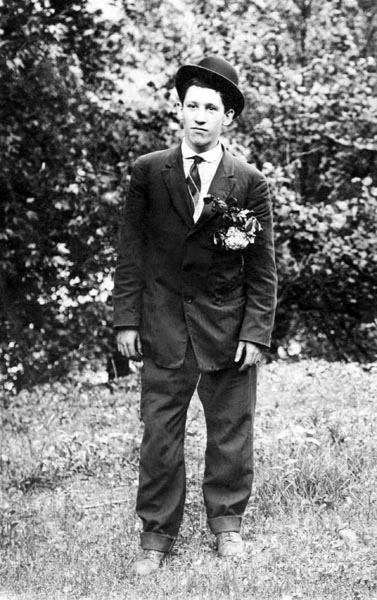"Blair Mountain changed my life!" Reflections on the 1921 Armed Miners' March
By Fred Barkey

Charlie Holstein, about the time of Blair Mountain, 1921. Photo courtesy of Fred Barkey.
Charlie didn’t remember the exact date, but sometime in late spring 1921, fellow union member Herb Hall approached him about organizing miners. The goal was to free fellow United Mine Workers of America (UMWA) members who’d been jailed illegally in Logan and Mingo counties. Charlie’s job was to help Herb mobilize miners living on the south side of the Kanawha River in eastern Kanawha County, specifically the area from Chesapeake to Pratt.
My father-in-law’s role in the armed miners march of 1921 was a stunning revelation to me. Since the 1960s, I’d studied and written about the West Virginia Mine Wars. Little did I know that my own father-in-law was a leader in the Battle of Blair Mountain. He even had proof of it—a slightly faded but well-preserved red bandana—an unofficial uniform accessory that earned the miners the nickname of the “Red Neck Army.” The bandana is now on display in the West Virginia State Museum.
When I finally sat down to talk with Charlie, he was initially hesitant, like most of the march participants. This just added to the whole mystery. But, as I delved more deeply into his story, I realized why he was chosen to serve on the frontlines of the largest armed uprising of workers in American labor history.
First of all, Charles Holstein was the son of a coal miner. Born in Winifrede in Kanawha County, he was the eldest child of Abraham Lincoln “Link” and Mattie McNeff Holstein. When he was about six years old, Charlie’s family moved a few miles up the Kanawha River to Coalburg, where “Link” worked in the mines owned by William Seymour Edwards, a well-known coal operator and Progressive Republican.
Young Charlie attended the community grade school, whose teacher had a college education—a rarity in those days—paid for by Edwards. Charlie was an adept and eager student, and Edwards tried to persuade him to attend high school. However, like many teenagers in the coalfields, the lure or necessity of a mining job was strong, so Charlie joined his father in the mines, where he labored for almost a decade.
During his time as a practical miner, Charlie became a union man and participated in several strikes, including the Paint Creek-Cabin Creek conflict of 1912-1913, the deadliest strike of the Mine Wars. His father ran unsuccessfully for office on the Socialist Party’s ticket in 1914. If “Link” had run in 1912 instead, he probably would’ve won since the Socialists carried the Paint Creek-Cabin Creek Magisterial District that year.
In the final analysis, however, the thing that especially brought Charlie to the attention of UMWA organizers was his recent service in the U.S. Army during World War I. Called to duty in 1917, Charlie went through basic training at Fort Lee, New Jersey. Just as he was getting ready to ship overseas, he contracted a serious case of Spanish flu, which had reached epidemic proportions. By the time he recovered, the Great War had ended, and Charlie returned to the mines—little realizing that his military training would be useful after all.
Charlie and Herb were tapped for leadership at a critical time in the UMWA’s drive to organize West Virginia’s southernmost counties. Many miners in Boone and Mingo counties were already conducting recognition strikes—intended to coerce coal operators into recognizing the union. Frank Keeney, the president of the UMWA’s District 17, was pushing coal operators to accept and deal with the union. The operators responded with heavy-handed resistance that, in turn, provoked a number of violent incidents—the most important being the Matewan Massacre in May 1920 and its aftermath, which coalesced upper Kanawha Valley miners around a common cause. As Charlie explained, “Herb and I had no problem in getting together a group of boys that we called the ‘early birds,’ who could be counted on to step forward when we needed to move on something.” That something began with an attempt to stockpile arms and ammunition.
You can read the rest of this article in this issue of Goldenseal, available in bookstores, libraries or direct from Goldenseal.